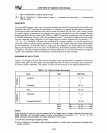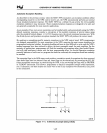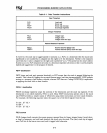
OVERVIEW
OF
NUMERIC PROCESSING
Table
1-17.
Exception
Conditions
and Masked Responses (Cont'd.)
Condition
Masked Response
Denormalized Operand
(FLD
instruction
only): source operand is
No
special action; load
as
usual.
denormal.
(Arithmetic
operations
only): one
or
both
Convert
(in
a work
area)
the operand to the
operands is
denormal. equivalent unnormal and proceed.
(Compare and test operations only): one or Convert
(in
a work area)
any
denormal to the
both operands is denormal
or
unnormal (other equivalent unnormal; normalize
as
much
as
than pseudo zero). possible, and proceed with operation.
Zero Divide
(Division operations only): divisor =
O.
Return
00
signed with
"exclusive
or"
of
operand signs;
Overflow
(Arithmetic
operations
only): rounding is Return properly signed
00
and
signal precision
nearest
or
chop,
and.
exponent
of
true result
exception.
>
16,383.
(FST, FSTP instructions only): rounding is Return properly signed
00
and
Signal
precision
nearest or chop,
and
exponent
of
true result
exception.
>
+127
(short real destination)
or>
+1023
(long real destination).
Underflow
(Arithmetic operations only): exponent of true
Denormalize until exponent rises to
-16,382
result <
-16,382
(true). (true), round significand to 64 bits. If denor-
mali zed rounded significand =
0,
then return
true
0;
else, return denormal (tag = special,
biased exponent
=
0).
(FST,
FSTP
instructions only): destination is Denormalize until exponent rises to
-126
short real
and
exponent
of
true result <
-126
(true), round significand to 24 bits, store true 0
(true). if denormalized rounded significand =
0;
else,
store denormal (biased exponent =
0).
(FST,
FSTP instructions only): destination is
Denormalize until exponent rises to
-1022
long
real
and
exponent of true result <
-1022
(true), round significand to 53 bits, store true 0
(true). if rounded denormalized significand =
0;
else,
store denormal (biased exponent
=
0).
Precision
True rounding error occurs. No special action.
Masked response to overflow exception earlier
No
special action.
in
instruction.
Note that when exceptions are masked, the
NPX
may detect multiple exceptions in a single instruction,
because it continues executing the instruction after performing its masked response. For example, the
80287 could detect a denormalized operand, perform its masked response to this exception, and then
detect an underflow.
1-36


















